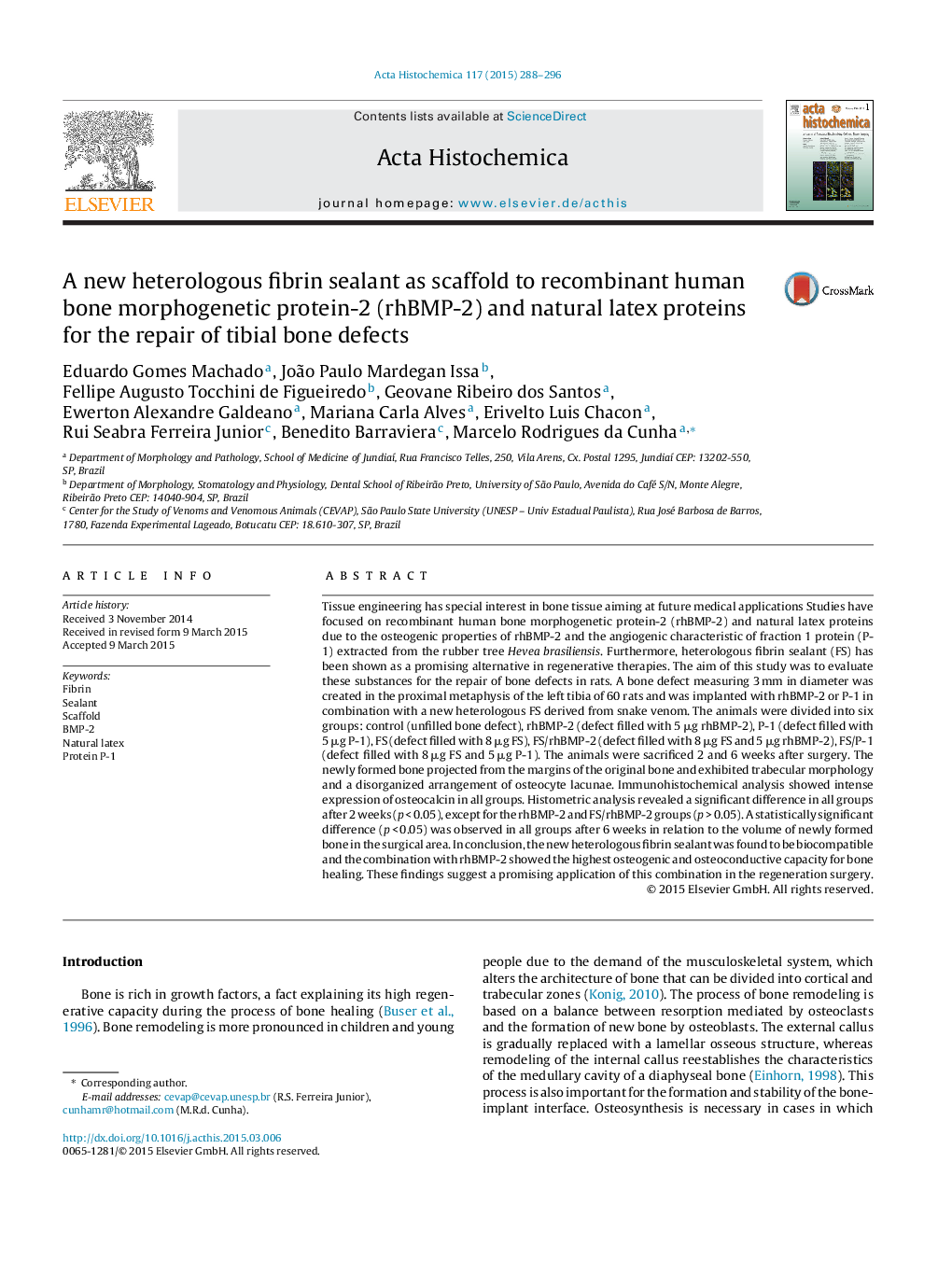| کد مقاله | کد نشریه | سال انتشار | مقاله انگلیسی | نسخه تمام متن |
|---|---|---|---|---|
| 10747087 | 1048887 | 2015 | 9 صفحه PDF | دانلود رایگان |
عنوان انگلیسی مقاله ISI
A new heterologous fibrin sealant as scaffold to recombinant human bone morphogenetic protein-2 (rhBMP-2) and natural latex proteins for the repair of tibial bone defects
دانلود مقاله + سفارش ترجمه
دانلود مقاله ISI انگلیسی
رایگان برای ایرانیان
موضوعات مرتبط
علوم زیستی و بیوفناوری
بیوشیمی، ژنتیک و زیست شناسی مولکولی
زیست شیمی
پیش نمایش صفحه اول مقاله

چکیده انگلیسی
Tissue engineering has special interest in bone tissue aiming at future medical applications Studies have focused on recombinant human bone morphogenetic protein-2 (rhBMP-2) and natural latex proteins due to the osteogenic properties of rhBMP-2 and the angiogenic characteristic of fraction 1 protein (P-1) extracted from the rubber tree Hevea brasiliensis. Furthermore, heterologous fibrin sealant (FS) has been shown as a promising alternative in regenerative therapies. The aim of this study was to evaluate these substances for the repair of bone defects in rats. A bone defect measuring 3 mm in diameter was created in the proximal metaphysis of the left tibia of 60 rats and was implanted with rhBMP-2 or P-1 in combination with a new heterologous FS derived from snake venom. The animals were divided into six groups: control (unfilled bone defect), rhBMP-2 (defect filled with 5 μg rhBMP-2), P-1 (defect filled with 5 μg P-1), FS (defect filled with 8 μg FS), FS/rhBMP-2 (defect filled with 8 μg FS and 5 μg rhBMP-2), FS/P-1 (defect filled with 8 μg FS and 5 μg P-1). The animals were sacrificed 2 and 6 weeks after surgery. The newly formed bone projected from the margins of the original bone and exhibited trabecular morphology and a disorganized arrangement of osteocyte lacunae. Immunohistochemical analysis showed intense expression of osteocalcin in all groups. Histometric analysis revealed a significant difference in all groups after 2 weeks (p < 0.05), except for the rhBMP-2 and FS/rhBMP-2 groups (p > 0.05). A statistically significant difference (p < 0.05) was observed in all groups after 6 weeks in relation to the volume of newly formed bone in the surgical area. In conclusion, the new heterologous fibrin sealant was found to be biocompatible and the combination with rhBMP-2 showed the highest osteogenic and osteoconductive capacity for bone healing. These findings suggest a promising application of this combination in the regeneration surgery.
ناشر
Database: Elsevier - ScienceDirect (ساینس دایرکت)
Journal: Acta Histochemica - Volume 117, Issue 3, April 2015, Pages 288-296
Journal: Acta Histochemica - Volume 117, Issue 3, April 2015, Pages 288-296
نویسندگان
Eduardo Gomes Machado, João Paulo Mardegan Issa, Fellipe Augusto Tocchini de Figueiredo, Geovane Ribeiro dos Santos, Ewerton Alexandre Galdeano, Mariana Carla Alves, Erivelto Luis Chacon, Rui Seabra Ferreira Junior, Benedito Barraviera,